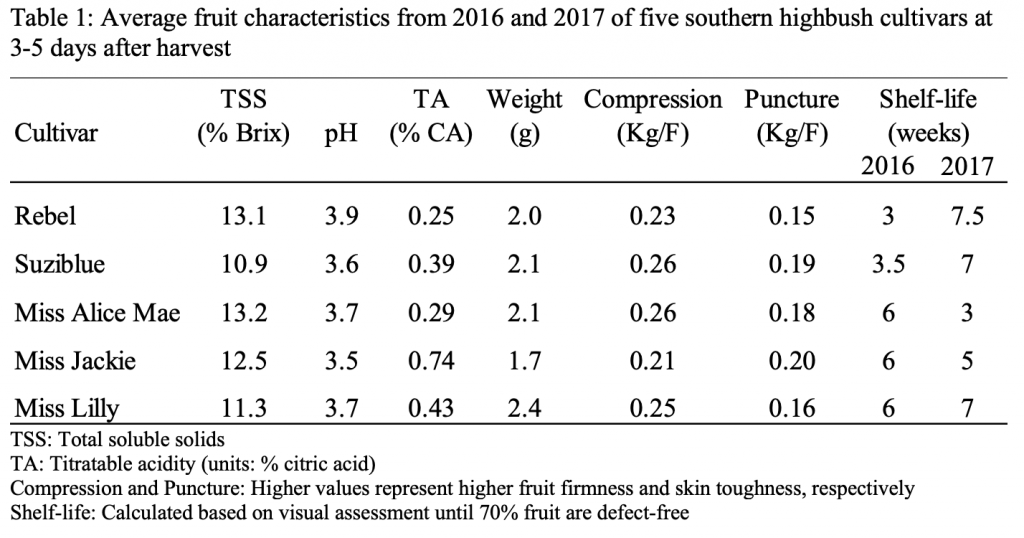Authors: Yi-Wen Wang, D. Scott NeSmith, Rachel Itle, Renée Holland, and Savithri Nambeesan.
In this study we evaluated postharvest fruit quality attributes of five southern highbush cultivars, Miss Lilly, Miss Alice Mae, Miss Jackie, Rebel and Suziblue. This article summarizes the fruit quality attributes of these 5 cultivars shortly after harvest and their postharvest shelf-life.
Methods: Fruit were collected in 2016 and 2017 from two different farms. In 2016, fruit were collected from the Blueberry Research Farm in Alapaha, GA. This farm has minimal preharvest management practices. In 2017, fruit were picked from a commercial farm. All fruit were hand harvested and packed into clamshells. After harvest, fruits were brought back to the University of Georgia, Athens campus. Fruit were re-sorted to include only healthy fruit into clamshells and stored in a walk-in cooler maintained at 4 oC at ~95% relative humidity. At regular intervals during postharvest storage fruit quality attributes were evaluated. These attributes include total soluble solids (TSS), pH, titratable acidity (TA), weight, texture, and percentage of defect free fruit. For determination of TSS, pH and TA, 40 g of fruit were pureed to extract juice (the supernatant after centrifugation and filtration). The juice was used to determine TSS using a digital handheld refractometer (Atago, USA) and pH and TA using an automatic mini titrator (Hanna Instruments, USA). Fruit weight was measured on 20 fruit using a precision balance (Sartorius Quintix® Precision Balance, USA). To determine fruit texture, two tests, compression and puncture, were performed on 12 fruit using a Guss-15 Texture Analyzer (Strand, South Africa). Compression is reflective of fruit firmness and puncture of skin toughness. Higher values represent firmer fruit and higher skin toughness. A visual assessment was performed with 30 fruit for symptoms of shriveling, cracking, bruising, or mold, and percent defect free fruit was calculated. Using this information, an arbitrary scale was developed for shelf-life; the time in weeks during storage until which fruit were 70% defect free.
Results: Results presented for fruit quality attributes in Table 1 are around 3-5 days after harvest (average of 2016 and 2017). Only shelf-life is shown separately for the two years (Table 1). Comparisons have been made among cultivars only shown for this study which include Rebel, Suziblue, Misses Alice Mae, Jackie and Lilly (Figure 1).
Rebel: Rebel is one of the early ripening cultivars. Rebel has a higher pH, lower TA and slightly lower compression (more soft) and puncture (less skin toughness). Fruit were collected from a research farm in 2016 compared to a commercial farm in 2017; farm management practices in the commercial farm extended shelf-life of Rebel from 3 weeks to greater than 7 weeks. Overall, Rebel is a softer fruit and therefore needs careful handling. With good management practices it can have a better shelf-life.
Suziblue: Suziblue is also a relatively early ripening cultivar. Overall, Suziblue is a good cultivar with respect to fruit firmness, TSS, TA and shelf-life. Again, with better management, fruit shelf-life can be extended.
Miss Alice Mae: Overall Miss Alice Mae is an early season cultivar and exhibits good fruit characteristics in terms of fruit weight, firmness, TSS and TA at harvest. Fruit from this cultivar may have displayed lower shelf-life in 2017 in the commercial farm since it was a relatively new planting with minimal management. Overall this cultivar has good fruit quality characteristics and can maintain postharvest fruit quality with good management.
Miss Jackie: This cultivar is mid-to late season and needs more evaluation. The data presented here show that Miss Jackie fruit have higher TA and lower fruit weight. However, Miss Jackie had a very good shelf-life with minimal management and therefore should be evaluated further to examine acceptance of its fruit quality characteristics.Miss Lilly: Overall Miss Lilly is an early season and exhibits good fruit characteristics at harvest. Fruit weight is comparatively higher than that in other cultivars. It has good firmness and acceptable TSS and TA values. It also has good shelf-life and has potential to be developed into a popular commercial cultivar.


Acknowledgements: The authors would like to thank the farm managers, Shane Tawzer at the Blueberry Research Farm in Alapaha and the commercial farm for coordinating fruit collections.